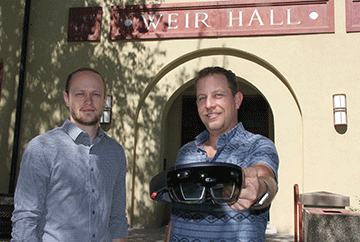
Undergrad Wins LANL Student Symposium Engineering Poster Contest Using AR.
 SOCORRO, N.M. – New Mexico Tech student Ben Katko is making nuclear criticality safety
more effective, efficient, and safe through Augmented Reality.
SOCORRO, N.M. – New Mexico Tech student Ben Katko is making nuclear criticality safety
more effective, efficient, and safe through Augmented Reality.
Not only did he win an award for his poster, but Katko also proposed an augmented reality project to Los Alamos National Laboratory and NMT. He managed to secure $23,000 in funding for his team’s Senior Design Clinic project.
Katko finished his third summer at LANL this year, culminating with a top award for his poster. Katko and teammate Brian Bleck, an undergrad at UNM, worked with Staff Research Engineer Dr. David Mascarenas to develop a novel ARsolution for all operations within a nuclear facility. AR is the placement of virtual objects (PDF documents) onto the physical space (nuclear canisters). In short, their invention augments the users with real-time knowledge, empowers users with the ability for on-the-fly documentation generation and viewing, and improves spatial, situational, and administrative awareness.
“Brian, David, and I are all competitive, so we had a good sense that we had something unique,” Katko said. “We just hoped the judges would recognize how unique our work was. I was pretty stoked. It made the summer worthwhile because this is more graduate level, Ph.D.-level research – how to make new engineering tools, the fundamentals behind creating new knowledge.
“You don’t always get to do that at the undergraduate level – and then getting this new Senior Design Clinic project,” Katko said. “This speaks to the character of New Mexico Tech and our mechanical engineering research – pushing boundaries and engaging students. We are aware of where the future is going and now shaping it.”
With the funding, Katko’s Senior Design Clinic team can support five mechanical engineering students. Katko hopes to double the team size in the future to include students from computer science and electrical engineering.
Katko is using the Microsoft HoloLens to create an AR tool. The HoloLens has four spatial cameras and one infrared receiver/transmitter, which gives depth to the four cameras – all in real time.
“The power of this tool is that it’s a hands-free device,” Katko said. An example of this summer’s research is “A glove box technician wearing the HoloLens can trigger hands-free events such as documentation viewing and video recording. The fewer times they have to take their hands out to review or amend documents, the safer the process is for them. This is empowering because every time they take their hands out of the glovebox they can potentially damage the glove material and, regardless, they must go through the protocol of radiation dosage evaluation.”
There is currently a great need for next-generation, human-machine interfaces to reduce the occurrence of criticality safety incidents during operations in nuclear facilities. The work shutdowns associated with criticality safety incidents can lead to significant losses in productivity. Katko’s innovation is meant to improve nuclear facility operations through the use of emerging AR technology which allows for easy, on-the-fly access to information which in turn augments the technician’s ability to operate more effectively, efficiently, and safer.
The AR work will be used in the future to help managers plan complicated material moves in ways that do not violate nuclear criticality safety regulations. Additionally, the nature of the AR technology (gaze, gesture and voice commands) makes it an attractive method for facilitating the training of technicians in nuclear material operations and work verification.
Katko’s work could be used across the Department of Energy complex to ensure technicians work safely and securely in a variety of scenarios. It would be a step forward in improving the quality of documentation of the work that occurs in nuclear facilities while simultaneously increasing the ease with which this documentation can be collected. In addition, there is potential that glove boxes could be instrumented with imagers to determine precise spatial locations of nuclear material containers at human speeds, further increasing criticality safety.
This information is fed into a criticality safety model. The results of the criticality safety analysis are then communicated visually to the glovebox technician using holograms displayed using AR technology. The AR effectively endows the nuclear facility managers, technicians, and operators with a sense for administrative nuclear criticality safety. AR technology also presents a potential path forward for next-generation smart personal protective equipment (PPE) that can be used in nuclear facilities.